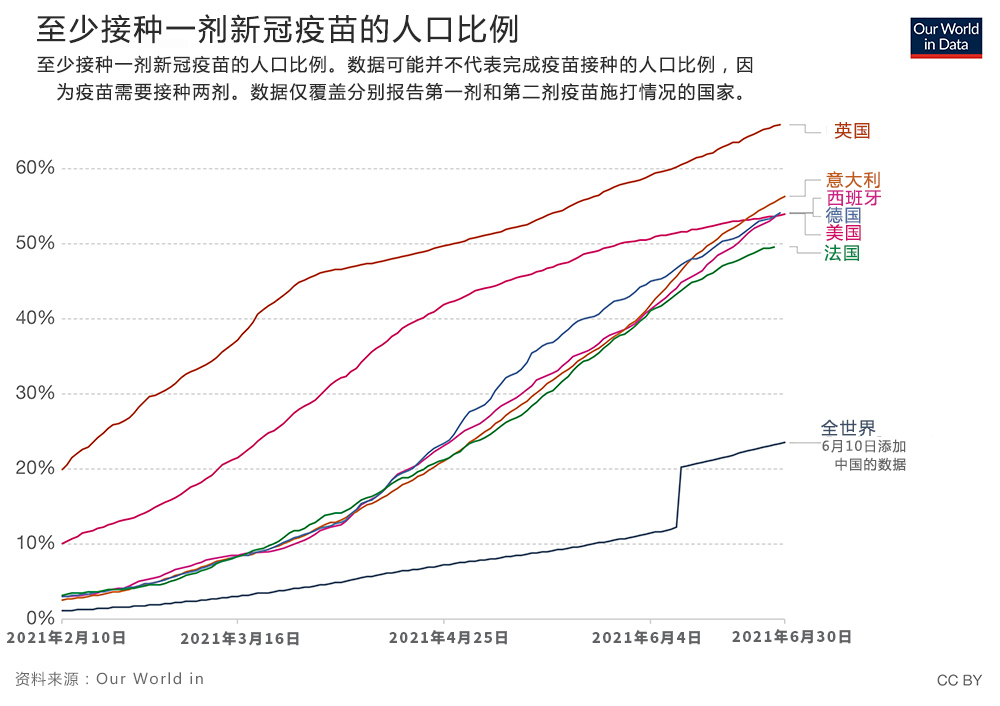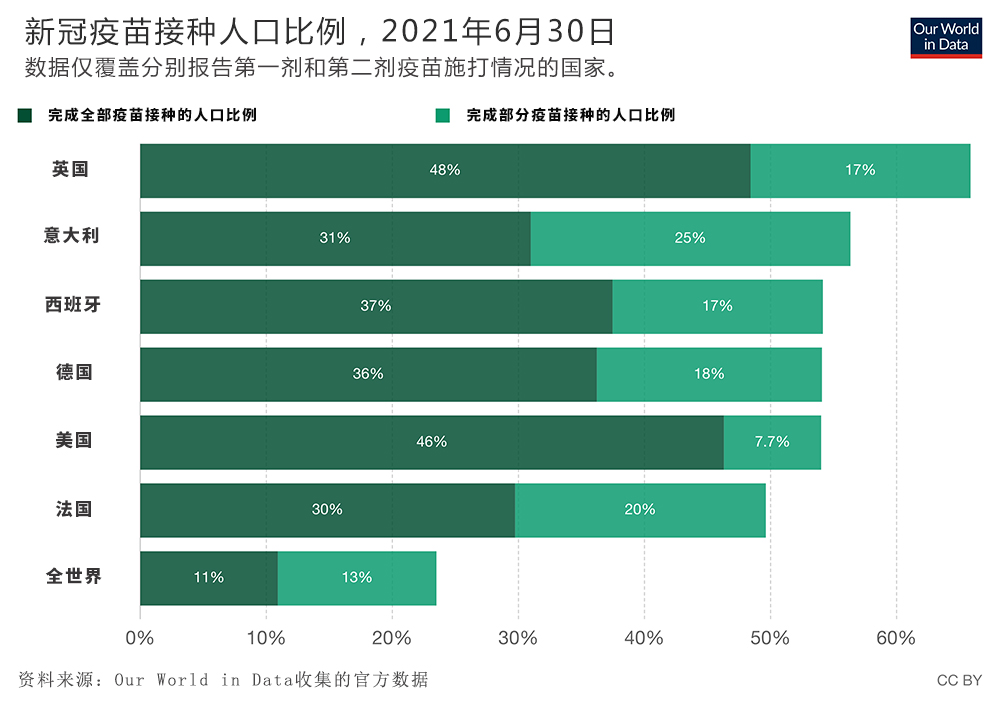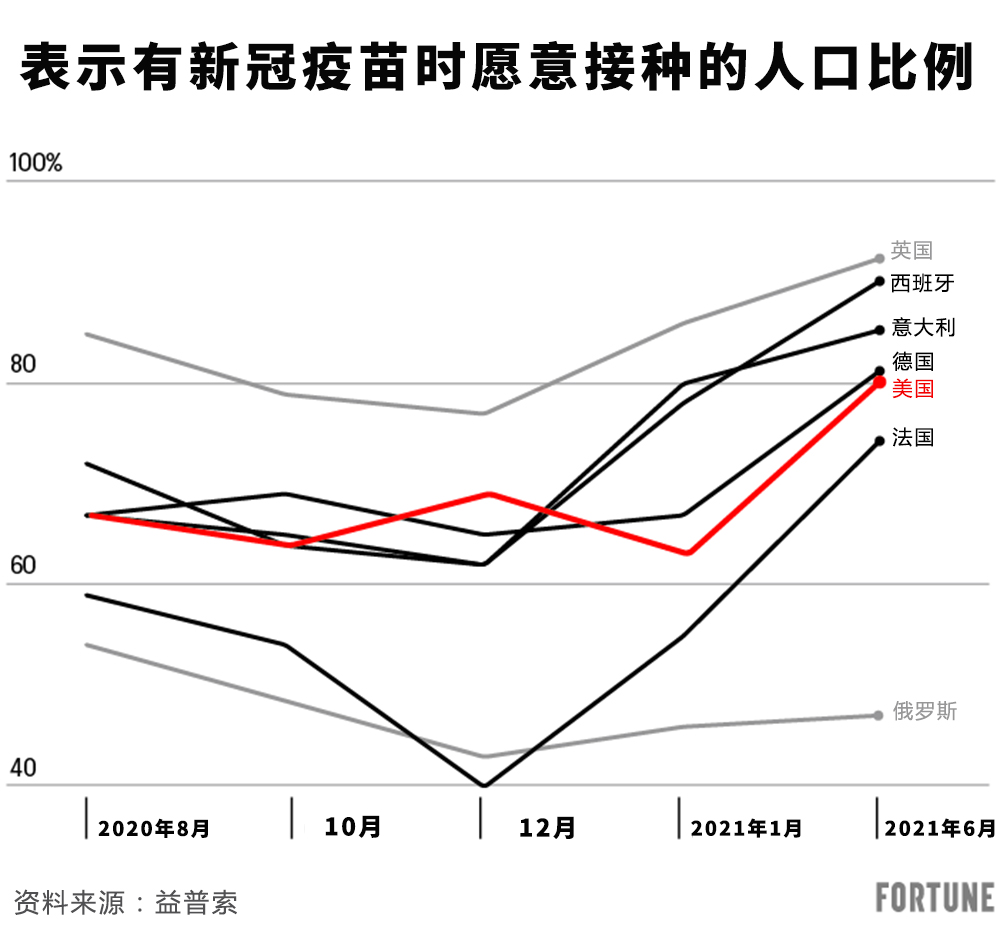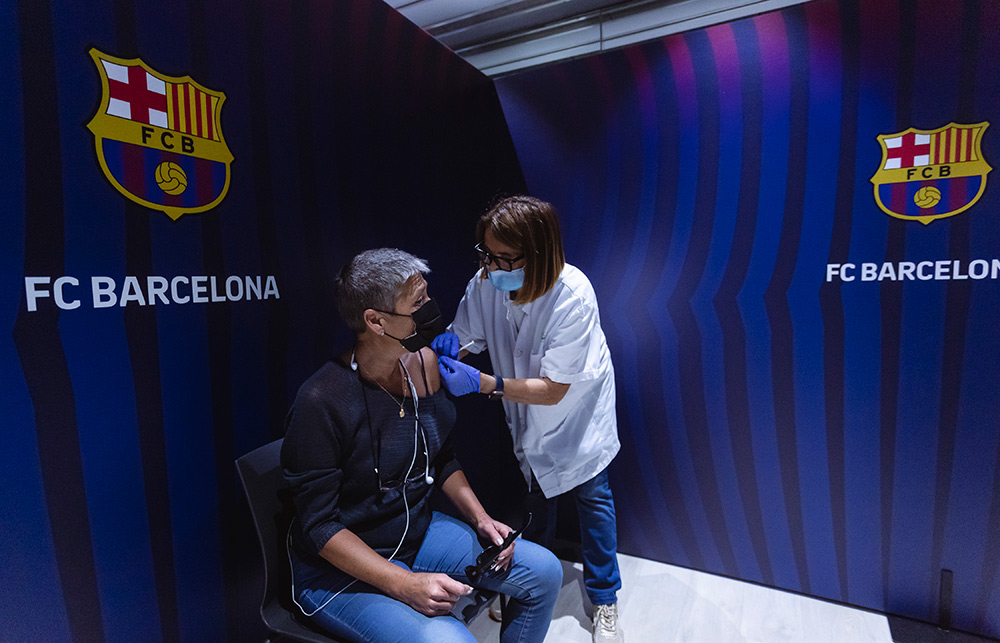欧洲疫苗接种速度反超美国
在全世界都在努力通过疫苗来摆脱新冠疫情的过程中,欧洲的新冠疫苗接种工作虽然开始时问题不断,但在六个月后其成果已经超过了美国。
上周,意大利、德国和西班牙至少接种一剂新冠疫苗的人口比例超过了美国,法国也已经与美国相差不远。截至6月29日,意大利、西班牙和德国至少接种一季新冠疫苗的人口比例在56%和54.1%之间,而美国为53.8%。(英国以65.9%遥遥领先于所有国家。)
在今年年初世界各地刚刚开始推行新冠疫苗的接种时,很少有人能够预见到这种形势逆转,而且当时美国似乎拥有其他任何国家都难以匹敌的资源优势。
欧洲的疫苗接种工作一度并不顺利。疫苗供应不足导致各方对于谁应该为漏洞百出的疫苗合同负责而相互推诿指责,于是欧盟领导人做出了有欠考虑的决定,将民众的怒火转移到英国和疫苗厂商阿斯利康(AstraZeneca)身上,并减少了欧盟的对外疫苗出口。开局不利影响了欧元区的经济,因为各成员国为了疫情防控采取了严格的封锁措施。
但后来欧洲各国政府组织了积极的疫苗接种活动,大力宣传支持疫苗接种的信息,最重要的是大批疫苗纷纷到货。
后来居上
另外,欧洲各国领导人鼓励接种疫苗,公众也普遍较少对医学持怀疑态度,这也是欧洲快速推动疫苗接种的原因之一。
除了法国以外,主要欧洲经济体的民众接种疫苗的意愿都高于美国。美国有较高比例的民众不愿意接种疫苗,延缓了疫苗接种计划的进展,导致美国的疫苗接种率始终维持在总人口的54%左右。
Our World in Data网站的最新数据显示了欧洲如何快速赶上并超越美国鼓吹的“曲速行动”(Operation Warp Speed)。该网站每天收集各国的新冠疫情数据。


益普索(Ipsos)提供给《财富》杂志的调查数据显示,在6月最后一周,德国已经接种或表示将会接种新冠疫苗的人口比例为81%,意大利为85%,西班牙为90%,美国和法国分别只有80%和74%。(YouGov的一项单独调查显示,美国和西班牙、德国与意大利之间的疫苗接受度差异更加明显。)

不过,欧洲的疫苗接种工作依旧有很长的路要走。
在美国,约46%的民众已经完成了(大部分)两剂疫苗接种,但在主要欧洲国家,这个比例为31%至37%。
这对于防控正在成为主要病毒的德尔塔变种病毒有重要的影响。早期研究显示,无论是BioNTech/辉瑞(Pfizer)疫苗还是牛津(Oxford)/阿斯利康疫苗,凡是需要接种两剂的疫苗,只有全部接种之后才能够形成对德尔塔病毒足够的免疫保护。另外,德国卫生部门表示,对于最早在印度发现的德尔塔病毒株,需要80%的人口完成疫苗接种才可以形成“基本保护”。
下文介绍了欧洲主要经济体在疫苗接种方面如何赶超美国。
意大利
3月,意大利新任总理马里奥•德拉吉任命弗朗赛斯科•保罗•菲格利奥罗将军负责全国疫苗接种工作。当时,意大利的疫苗接种工作陷入困境,他在其中带来了军事行动般的精密度,随着5月疫苗供应量增加,疫苗接种工作开始加速。
目前,意大利每三周有超过10%的人口接种疫苗,有望兑现菲格利奥罗在3月做出的承诺。他当时向质疑者承诺在9月底之前使80%的意大利人完成疫苗接种。
菲格利奥罗上任时,有超过3万意大利人因为新冠疫情而住院治疗,其中3,800人正在接受重症监护。上周,意大利卫生部部长罗伯托•斯佩兰萨得意地宣布,这些数字下降了90%。
对大部分意大利人而言,本国的公共医疗保健体系依旧是民族自豪感的来源之一。这或许可以解释为什么最近的民意调查数据显示,意大利人具有相对较高的新冠疫苗接受度。随着疫苗供应不足的问题得到解决,被抑制的需求预计将帮助意大利在今年夏天之前,实现为所有成年国民接种至少一剂疫苗的目标。
德国
上周早些时候,德国至少接种一剂疫苗的人口比例超过美国,这证明卫生部部长延斯•施潘在6月初的决定是正确的。他当时决定取消对成年人接种疫苗的优先限制。例如柏林和巴伐利亚等州不久前也采取了类似的措施,一度遭到德国医师协会(German Doctors’ Association)主席苏珊娜•约翰纳的批评。她曾经抱怨称“现在将有更多人争抢稀缺的疫苗。”
但事实证明,疫苗稀缺的问题很快就得到了解决,而这一定程度上要得益于美国进展缓慢的疫苗接种行动。简而言之,美国民众对接种新冠疫苗的意愿较低,这意味着,未使用的疫苗必须在过期之前供应给其他地区,有些欧洲国家很快将这些疫苗抢购一空。
来自美国的Moderna疫苗出人意料地加快了供应速度,令丹麦、克罗地亚和德国受益。德国本来预计本月每周可以获得73.3万剂Moderna疫苗,但周末,施潘表示,7月的疫苗进口量达到每周133万剂。根据目前的预测,预计9月每周将有约300万剂Moderna疫苗供应德国。
施潘在周六表示,疫苗很快就会供大于求,在各地医疗诊所已经有数以万计未使用的牛津/阿斯利康和强生(Johnson & Johnson)疫苗。许多德国人认为这两款疫苗的效果低于Moderna和BioNTech/辉瑞的mRNA疫苗。
施潘表示,为了尽快为80%的人口接种疫苗和防止德尔塔变种病毒传播,德国医护人员很快将在市中心和教堂等地为行人接种疫苗。事实上,德国将有足够的疫苗,甚至计划在今年下半年对外出售3,000万剂。
西班牙
西班牙疫苗接种工作的转机出现在4月初。当时,西班牙政府因为疫苗接种工作开展缓慢和经济困境而备受指责,于是西班牙总理佩德罗•桑切斯宣布开启“西班牙史上规模最大的疫苗接种行动”。
2021年前三个月,西班牙获得了970万剂疫苗,但只有550万西班牙人至少接种了一剂疫苗,仅占总人口的11.7%。桑切斯在4月的讲话中表示,第二季度的疫苗供应量将达到3,800万剂,并提出了一系列疫苗工作的里程碑。
随着疫苗供应量增加,西班牙各地的医疗部门纷纷开始积极推动疫苗接种。在巴塞罗那,加泰罗尼亚政府在巴塞罗那菲拉会展中心(Fira convention center)和巴塞罗那足球俱乐部(FC Barcelona)的诺坎普(Camp Nou)球场开展大规模疫苗接种,马德里则在WiZink音乐厅和马德里竞技足球俱乐部(Atlético de Madrid)的球场进行大规模疫苗接种。

上周,以热闹的夜生活著称的马德里在一家地区医院设立了24小时大规模疫苗接种中心,首晚接种了827剂疫苗。马德里相对较早解除了限制措施。在安达卢西亚南部地区,当地政府采取了更多激励措施,宣布为在本地停留超过一个月的游客接种疫苗。
虽然西班牙距离6月中旬1,500万人完成疫苗接种的目标仍然相差约57万人,而且截至6月29日预计第二季度施打的3,800万剂疫苗仅施打了3,550万剂,但政府积极推动疫苗接种的努力以及民众较高的疫苗接种意愿,已经使53.4%的人口(2,530万)至少接种了一剂疫苗。YouGov调查发现,有91%的西班牙人表示已经接种或愿意接种一种疫苗。
原世界卫生组织(WHO)主任和巴斯克地区卫生部长拉斐尔•本戈亚称:“西班牙制定了雄心勃勃的计划,疫苗接种工作进展顺利。”他还表示在9月之前将有70%的成年人完成疫苗接种。
但本戈亚警告不能放松警惕,因为在未接种疫苗的青少年当中曾经发生过超级传播者事件,导致感染率再次攀升,比如马略卡地区的大规模毕业派对造成超过1,200人感染。
法国
法国民众接种疫苗的意愿普遍不高,而且与其他欧盟国家一样,法国也面临新冠疫苗短缺的问题。面对这种情况,法国总统埃马纽埃尔•马克龙选择了谨慎的做法,因此自去年圣诞节以来,疫苗接种工作一直没有起色。
法国只有约6万名医生被批准为民众接种疫苗。每次接种之前必须向医生了解潜在的风险,之后还需要签署知情同意书。法国经济学家安托万•列维当时告诉《财富》杂志:“我们陷入了卡夫卡式的困境。”
今年春天,第二波疫情爆发,每日新增病例超过35,000例,迫使马克龙最终放弃了缓行策略。他在消防站安排消防员为民众接种疫苗,并把巴黎可容纳81,000人的国家足球场改造成大规模疫苗接种站,每天能够为数千人接种疫苗。
6月29日,法国卫生官员在巴黎空旷的共和国广场(Place de la République)设立了快闪式疫苗接种帐篷,为送餐员接种疫苗,因为他们的工作时间导致他们很难前往疫苗接种站接种疫苗。对许多送餐员而言,在骑车经过的时候就可以接种疫苗,甚至不必锁车,这是不容错过的便利措施。Uber Eats的送餐员吉尧姆•吉拉德告诉《费加罗报》(Le Figaro):“这里不需要预约,而且我工作的地方距离共和国广场不远,所以我选择来这里接种疫苗。”
法国现在每周接种疫苗的人口比例是美国的三倍以上。上周,法国接种疫苗的人口比例是8.6%,而美国只有约2.5%。(财富中文网)
翻译:刘进龙
审校:汪皓
在全世界都在努力通过疫苗来摆脱新冠疫情的过程中,欧洲的新冠疫苗接种工作虽然开始时问题不断,但在六个月后其成果已经超过了美国。
上周,意大利、德国和西班牙至少接种一剂新冠疫苗的人口比例超过了美国,法国也已经与美国相差不远。截至6月29日,意大利、西班牙和德国至少接种一季新冠疫苗的人口比例在56%和54.1%之间,而美国为53.8%。(英国以65.9%遥遥领先于所有国家。)
在今年年初世界各地刚刚开始推行新冠疫苗的接种时,很少有人能够预见到这种形势逆转,而且当时美国似乎拥有其他任何国家都难以匹敌的资源优势。
欧洲的疫苗接种工作一度并不顺利。疫苗供应不足导致各方对于谁应该为漏洞百出的疫苗合同负责而相互推诿指责,于是欧盟领导人做出了有欠考虑的决定,将民众的怒火转移到英国和疫苗厂商阿斯利康(AstraZeneca)身上,并减少了欧盟的对外疫苗出口。开局不利影响了欧元区的经济,因为各成员国为了疫情防控采取了严格的封锁措施。
但后来欧洲各国政府组织了积极的疫苗接种活动,大力宣传支持疫苗接种的信息,最重要的是大批疫苗纷纷到货。
后来居上
另外,欧洲各国领导人鼓励接种疫苗,公众也普遍较少对医学持怀疑态度,这也是欧洲快速推动疫苗接种的原因之一。
除了法国以外,主要欧洲经济体的民众接种疫苗的意愿都高于美国。美国有较高比例的民众不愿意接种疫苗,延缓了疫苗接种计划的进展,导致美国的疫苗接种率始终维持在总人口的54%左右。
Our World in Data网站的最新数据显示了欧洲如何快速赶上并超越美国鼓吹的“曲速行动”(Operation Warp Speed)。该网站每天收集各国的新冠疫情数据。
益普索(Ipsos)提供给《财富》杂志的调查数据显示,在6月最后一周,德国已经接种或表示将会接种新冠疫苗的人口比例为81%,意大利为85%,西班牙为90%,美国和法国分别只有80%和74%。(YouGov的一项单独调查显示,美国和西班牙、德国与意大利之间的疫苗接受度差异更加明显。)
不过,欧洲的疫苗接种工作依旧有很长的路要走。
在美国,约46%的民众已经完成了(大部分)两剂疫苗接种,但在主要欧洲国家,这个比例为31%至37%。
这对于防控正在成为主要病毒的德尔塔变种病毒有重要的影响。早期研究显示,无论是BioNTech/辉瑞(Pfizer)疫苗还是牛津(Oxford)/阿斯利康疫苗,凡是需要接种两剂的疫苗,只有全部接种之后才能够形成对德尔塔病毒足够的免疫保护。另外,德国卫生部门表示,对于最早在印度发现的德尔塔病毒株,需要80%的人口完成疫苗接种才可以形成“基本保护”。
下文介绍了欧洲主要经济体在疫苗接种方面如何赶超美国。
意大利
3月,意大利新任总理马里奥•德拉吉任命弗朗赛斯科•保罗•菲格利奥罗将军负责全国疫苗接种工作。当时,意大利的疫苗接种工作陷入困境,他在其中带来了军事行动般的精密度,随着5月疫苗供应量增加,疫苗接种工作开始加速。
目前,意大利每三周有超过10%的人口接种疫苗,有望兑现菲格利奥罗在3月做出的承诺。他当时向质疑者承诺在9月底之前使80%的意大利人完成疫苗接种。
菲格利奥罗上任时,有超过3万意大利人因为新冠疫情而住院治疗,其中3,800人正在接受重症监护。上周,意大利卫生部部长罗伯托•斯佩兰萨得意地宣布,这些数字下降了90%。
对大部分意大利人而言,本国的公共医疗保健体系依旧是民族自豪感的来源之一。这或许可以解释为什么最近的民意调查数据显示,意大利人具有相对较高的新冠疫苗接受度。随着疫苗供应不足的问题得到解决,被抑制的需求预计将帮助意大利在今年夏天之前,实现为所有成年国民接种至少一剂疫苗的目标。
德国
上周早些时候,德国至少接种一剂疫苗的人口比例超过美国,这证明卫生部部长延斯•施潘在6月初的决定是正确的。他当时决定取消对成年人接种疫苗的优先限制。例如柏林和巴伐利亚等州不久前也采取了类似的措施,一度遭到德国医师协会(German Doctors’ Association)主席苏珊娜•约翰纳的批评。她曾经抱怨称“现在将有更多人争抢稀缺的疫苗。”
但事实证明,疫苗稀缺的问题很快就得到了解决,而这一定程度上要得益于美国进展缓慢的疫苗接种行动。简而言之,美国民众对接种新冠疫苗的意愿较低,这意味着,未使用的疫苗必须在过期之前供应给其他地区,有些欧洲国家很快将这些疫苗抢购一空。
来自美国的Moderna疫苗出人意料地加快了供应速度,令丹麦、克罗地亚和德国受益。德国本来预计本月每周可以获得73.3万剂Moderna疫苗,但周末,施潘表示,7月的疫苗进口量达到每周133万剂。根据目前的预测,预计9月每周将有约300万剂Moderna疫苗供应德国。
施潘在周六表示,疫苗很快就会供大于求,在各地医疗诊所已经有数以万计未使用的牛津/阿斯利康和强生(Johnson & Johnson)疫苗。许多德国人认为这两款疫苗的效果低于Moderna和BioNTech/辉瑞的mRNA疫苗。
施潘表示,为了尽快为80%的人口接种疫苗和防止德尔塔变种病毒传播,德国医护人员很快将在市中心和教堂等地为行人接种疫苗。事实上,德国将有足够的疫苗,甚至计划在今年下半年对外出售3,000万剂。
西班牙
西班牙疫苗接种工作的转机出现在4月初。当时,西班牙政府因为疫苗接种工作开展缓慢和经济困境而备受指责,于是西班牙总理佩德罗•桑切斯宣布开启“西班牙史上规模最大的疫苗接种行动”。
2021年前三个月,西班牙获得了970万剂疫苗,但只有550万西班牙人至少接种了一剂疫苗,仅占总人口的11.7%。桑切斯在4月的讲话中表示,第二季度的疫苗供应量将达到3,800万剂,并提出了一系列疫苗工作的里程碑。
随着疫苗供应量增加,西班牙各地的医疗部门纷纷开始积极推动疫苗接种。在巴塞罗那,加泰罗尼亚政府在巴塞罗那菲拉会展中心(Fira convention center)和巴塞罗那足球俱乐部(FC Barcelona)的诺坎普(Camp Nou)球场开展大规模疫苗接种,马德里则在WiZink音乐厅和马德里竞技足球俱乐部(Atlético de Madrid)的球场进行大规模疫苗接种。
上周,以热闹的夜生活著称的马德里在一家地区医院设立了24小时大规模疫苗接种中心,首晚接种了827剂疫苗。马德里相对较早解除了限制措施。在安达卢西亚南部地区,当地政府采取了更多激励措施,宣布为在本地停留超过一个月的游客接种疫苗。
虽然西班牙距离6月中旬1,500万人完成疫苗接种的目标仍然相差约57万人,而且截至6月29日预计第二季度施打的3,800万剂疫苗仅施打了3,550万剂,但政府积极推动疫苗接种的努力以及民众较高的疫苗接种意愿,已经使53.4%的人口(2,530万)至少接种了一剂疫苗。YouGov调查发现,有91%的西班牙人表示已经接种或愿意接种一种疫苗。
原世界卫生组织(WHO)主任和巴斯克地区卫生部长拉斐尔•本戈亚称:“西班牙制定了雄心勃勃的计划,疫苗接种工作进展顺利。”他还表示在9月之前将有70%的成年人完成疫苗接种。
但本戈亚警告不能放松警惕,因为在未接种疫苗的青少年当中曾经发生过超级传播者事件,导致感染率再次攀升,比如马略卡地区的大规模毕业派对造成超过1,200人感染。
法国
法国民众接种疫苗的意愿普遍不高,而且与其他欧盟国家一样,法国也面临新冠疫苗短缺的问题。面对这种情况,法国总统埃马纽埃尔•马克龙选择了谨慎的做法,因此自去年圣诞节以来,疫苗接种工作一直没有起色。
法国只有约6万名医生被批准为民众接种疫苗。每次接种之前必须向医生了解潜在的风险,之后还需要签署知情同意书。法国经济学家安托万•列维当时告诉《财富》杂志:“我们陷入了卡夫卡式的困境。”
今年春天,第二波疫情爆发,每日新增病例超过35,000例,迫使马克龙最终放弃了缓行策略。他在消防站安排消防员为民众接种疫苗,并把巴黎可容纳81,000人的国家足球场改造成大规模疫苗接种站,每天能够为数千人接种疫苗。
6月29日,法国卫生官员在巴黎空旷的共和国广场(Place de la République)设立了快闪式疫苗接种帐篷,为送餐员接种疫苗,因为他们的工作时间导致他们很难前往疫苗接种站接种疫苗。对许多送餐员而言,在骑车经过的时候就可以接种疫苗,甚至不必锁车,这是不容错过的便利措施。Uber Eats的送餐员吉尧姆•吉拉德告诉《费加罗报》(Le Figaro):“这里不需要预约,而且我工作的地方距离共和国广场不远,所以我选择来这里接种疫苗。”
法国现在每周接种疫苗的人口比例是美国的三倍以上。上周,法国接种疫苗的人口比例是8.6%,而美国只有约2.5%。(财富中文网)
翻译:刘进龙
审校:汪皓
After a bumbling start, Europe has surpassed the U.S. in its COVID vaccine drive, just over six months into an international effort to vaccinate the world out of the coronavirus pandemic.
In the past week, Italy, Germany, and Spain have all overtaken the U.S. in terms of the percentage of the population that has received at least one shot against COVID-19, with France running close behind. As of June 29, Italy, Spain, and Germany have rates between 56% and 54.1%, while the U.S. stood at 53.8%. (The U.K., with a rate of 65.9%, is well ahead of them all.)
Few would have predicted this turn of events at the start of the year, when the world’s vaccine campaigns began taking off, and the U.S. resource advantage seemed insurmountable.
Europe’s vaccine rollout was disastrous. Supply shortfalls prompted a vicious blame game over who was responsible for negotiating what were seen as flawed vaccine contracts, and in response EU leaders engaged in an ill-advised effort to shift citizen ire to the U.K. and vaccine maker AstraZeneca and cut jab exports from the bloc. The slow start also sank the eurozone economy as member states adopted strict lockdown measures to curb contagion.
Since then, however, European governments have organized aggressive vaccination campaigns, engaged in intense pro-vaccine messaging, and, most important, received a flood of supply from vaccine makers.
Operation Overtake
Europe has also been aided by leaders who have promoted vaccine use, and a public that is generally less skeptical of medical science.
With the exception of France, vaccine willingness in major European economies is higher than that in the U.S., where high vaccine hesitancy has slowed the push, leading the U.S. vaccination rate to plateau at around 54% of the population.
The latest figures from Our World in Data, which collects national COVID data on a daily basis, shows how quickly Europe has caught up and overtaken America’s vaunted “Operation Warp Speed.”
In the final week of June, the number of people who said they had or would take the vaccine ranged from 81% in Germany to 85% in Italy to 90% in Spain, with the U.S. and France trailing, posting rates of 80% and 74%, respectively, according to survey data supplied to Fortune by Ipsos. (A separate survey, from YouGov, meanwhile, showed an even starker vaccine acceptance divide between the United States and the Spanish-German-Italian bloc.)
Still, Europe has a way to go in its vaccination efforts.
In the U.S., some 46% of people have fully completed their (mostly) two-dose vaccine regimens, while in major European countries the rates range from 31% to 37%.
That has major implications for handling the Delta variant of the coronavirus, which is on track to become the dominant strain. Early studies show both doses of the two-jab vaccines, such as those from BioNTech/Pfizer and Oxford/AstraZeneca, are needed to provide sufficient protection against Delta. For good measure, German health authorities say that full coverage of 80% of the population will be needed to provide “basic protection” against this particular strain, which was first identified in India.
Meanwhile, here is how Europe’s biggest economies caught up to the United States.
Italy
In March, Italy’s newly installed Prime Minister Mario Draghi appointed an army general, Francesco Paolo Figliuolo, to run the country’s vaccination drive. He brought military precision to a floundering campaign, and once supplies picked up in May, the campaign went into overdrive.
Italy is currently on pace to vaccinate a bit more than 10% of the country every three weeks, which should put it in line to hit Figliuolo’s vow, made in March to much skepticism, of fully vaccinating 80% of Italians by the end of September.
When Figliuolo took over, there were more than 30,000 Italians in the hospital with COVID, with 3,800 in intensive care. Those numbers have fallen by 90% since, Italy’s health minister, Roberto Speranza, triumphantly declared last week.
For most Italians, the public health care system is still a source of national pride. That may go some way to explaining the most recent polling data showing relatively high vaccine acceptance rates for the COVID jab. Now that the supply bottleneck of jabs is sorted out, pent-up demand is expected to help the country achieve its goal of getting all adult Italians at least one jab this summer.
Germany
Germany’s overtaking of the U.S. on initial doses earlier this week came as vindication of health minister Jens Spahn’s decision to remove prioritization limits on vaccinations for adults in early June. Some states, including Berlin and Bavaria, had made similar moves not long before, drawing criticism from Susanne Johna, head of the German Doctors’ Association, who complained that “even more people are now competing for a scarce commodity.”
As it turned out, the commodity quickly became less scarce—in part thanks to the slowdown in the U.S. vaccination drive. In short, American vaccine hesitancy means unused doses need to go somewhere before they expire, and some European countries have been quick to snap them up.
Along with Denmark and Croatia, Germany has been a major beneficiary of Moderna vaccines coming in from the U.S. at higher rates than previously foreseen. Germany was expecting to receive 733,000 Moderna doses per week this month, but on the weekend Spahn said the July intake would reach a whopping 1.33 million per week. Under current forecasts, nearly 3 million Moderna doses will be arriving per week in September.
Supply will soon outstrip demand, Spahn said Saturday, noting that hundreds of thousands of Oxford/AstraZeneca and Johnson & Johnson doses—seen by many Germans as inferior to Moderna and BioNTech/Pfizer’s mRNA-based vaccines—are already sitting unused in medical practices.
The minister said German health workers will soon be able to start offering shots to passersby in city centers and at places of worship, as the country races to hit the 80% target and beat the Delta variant. Indeed, Germany will be swimming in so many doses that it aims to sell on 30 million in the second half of the year.
Spain
Spain’s vaccine turnaround began in early April, when Prime Minister Pedro Sánchez, under fire for Spain’s slow rollout and devastated economy, announced the beginning of the “largest vaccination campaign in the history of Spain.”
During the first three months of 2021, Spain had been supplied with 9.7 million vaccine doses and only 5.5 million Spaniards—or 11.7% of the population—had received at least one dose. In his April speech, Sánchez said deliveries in the second quarter would jump to 38 million doses, and set out a series of vaccination milestones.
Faced with a flood of vaccines, Spain’s regional health departments set up aggressive vaccination programs. In Barcelona, the Catalan government repurposed the Fira convention center and the Camp Nou stadium of FC Barcelona for mass vaccinations, while Madrid opened mass vaccination centers in the downtown WiZink concert hall and the Atlético de Madrid soccer stadium.
Last week, Madrid—a region known for its active nightlife and relatively early loosening of COVID restrictions—went further, opening a 24-hour mass vaccination center in an area hospital, which administered 827 doses the first night. And in the southern region of Andalucía, the regional government added another incentive, announcing that it would offer doses to tourists staying for more than a month.
While Spain fell some 570,000 short of its mid-June goal of 15 million fully immunized people, and by June 29 had only received 35.5 million of the 38 million doses expected in the second quarter, the aggressive vaccine rollout, aided by a low level of vaccine hesitancy—91% of Spaniards said they had received or would receive a vaccine, according to YouGov—had gotten 53.4% of the population, or 25.3 million, vaccinated with at least one dose.
“Vaccination in Spain has advanced well, according to an ambitious plan,” said Rafael Bengoa, a former WHO director and health minister of the Basque region, adding that Spain should have 70% of its adult population fully vaccinated by September.
Bengoa counseled caution, however, noting that infection rates are rising again after superspreader events among unvaccinated youth, such as massive end-of-school parties in Mallorca that left more than 1,200 people infected.
France
Facing widespread vaccine hesitancy among the French—and, like much of the European Union, a dire shortage of COVID-19 vaccines—President Emmanuel Macron chose such a cautious approach that the program virtually stalled on takeoff around Christmas last year.
Only the country’s 60,000 or so physicians were authorized to vaccinate people. And each jab required a consultation with a doctor about the possible risks, and after that, a signed consent form. “We are in Kafka territory here,” French economist Antoine Lévy told Fortune at the time.
Macron finally jettisoned his go-slow strategy after the second coronavirus wave sent new cases soaring in the spring, to more than 35,000 a day. He deployed firefighters to vaccinate people at their stations and turned the country’s national football stadium in Paris, which seats 81,000 people, into a mass vaccination site capable of jabbing thousands of people a day.
And on June 29 health officials erected a pop-up vaccination marquee in Paris’s huge Place de la République, specifically to vaccinate food-delivery gig workers, whose working hours made it difficult to get to vaccination sites. For many delivery workers, being able to cycle by for a vaccine without even locking up their bikes was too convenient an offer to pass up. “Since this is without an appointment, and I don’t work far from République, I came,” Guillaume Girard, who delivers for Uber Eats, told Le Figaro.
France is now vaccinating more than three times the percentage of people as the U.S., up to about 8.6 per 100 people over the past week, compared with the U.S. rate of about 2.5.













